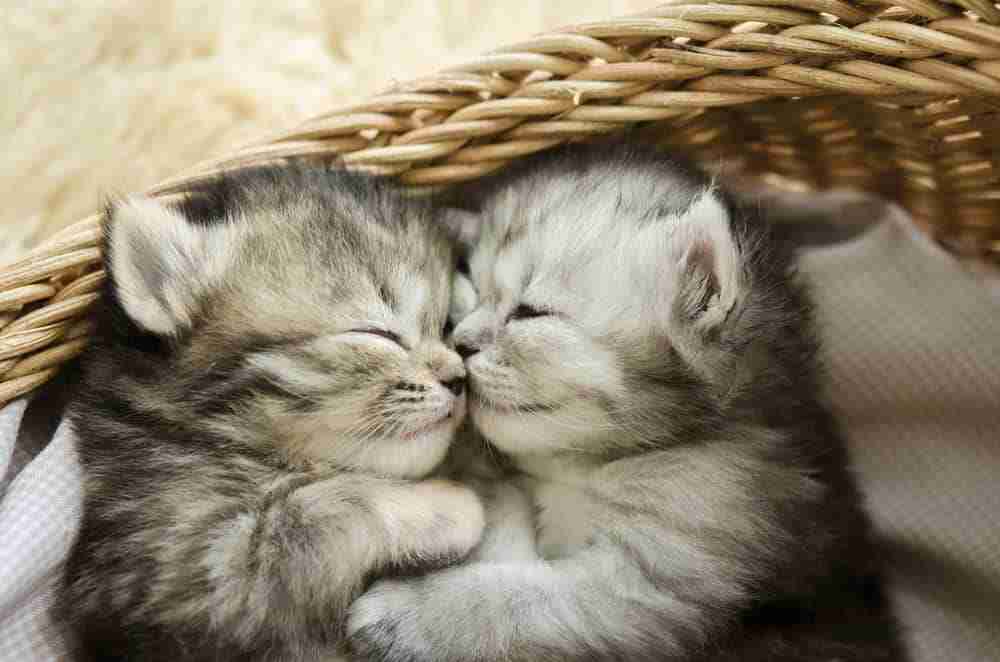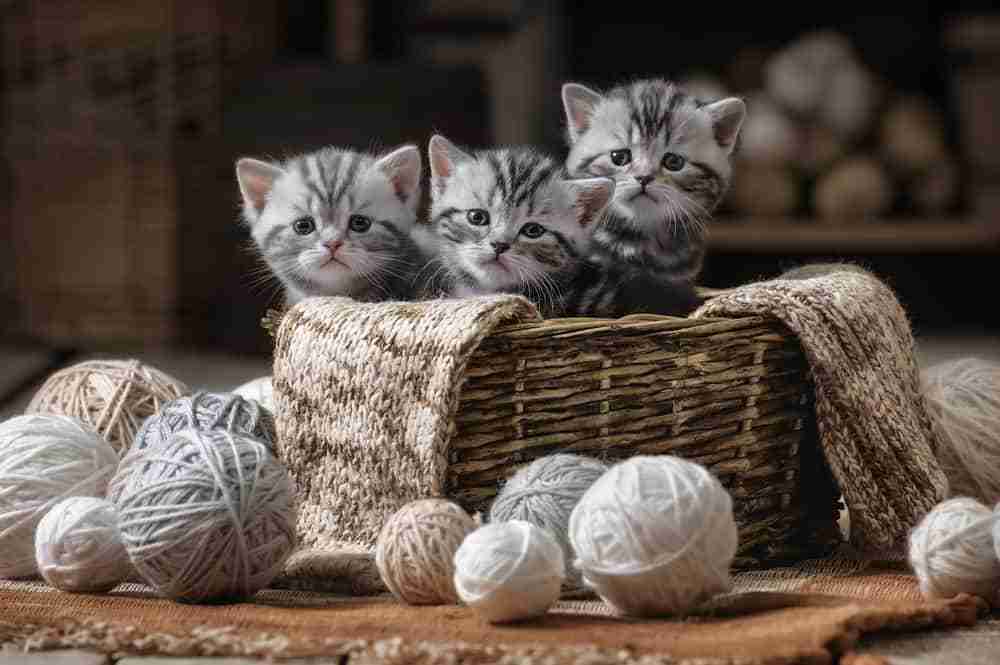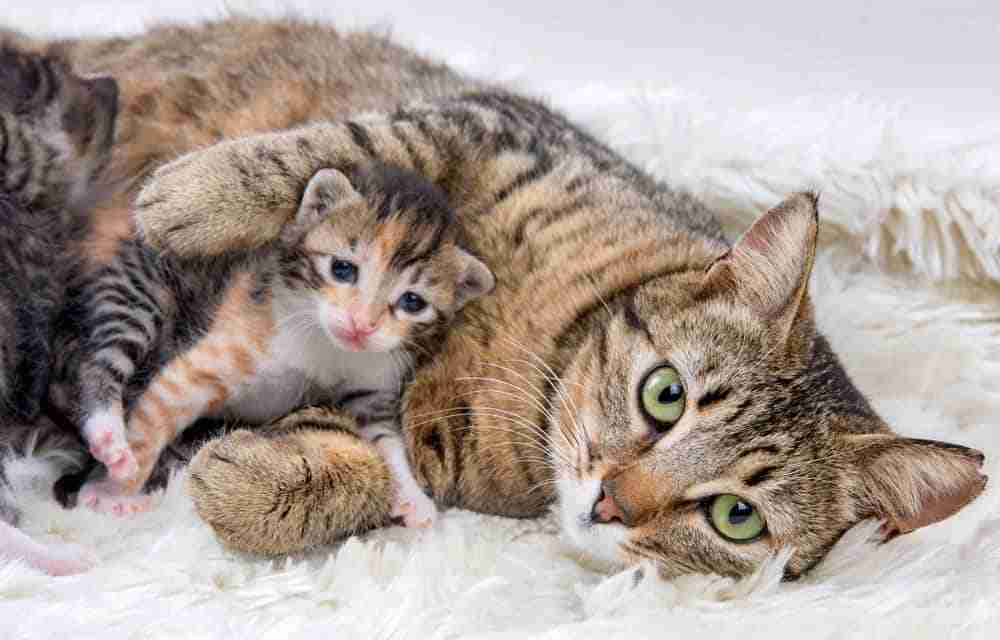Mother cats can have a very special relationship with their kittens. From their birth, kittens have a close bond with the mother cat which can last for months.
In nature, this close relationship between mothers and their kittens helps to keep smaller cats safe from danger and predators. When cats are kept as pets, the same relationship still exists for the same reasons.
- Mother Cats And Kittens
- What About Male Cats And Kittens?
- Why Would A Mother Cat Be Away From Her Kittens?
- It’s About Time
- Short Versus Long-Term Separation
- Separating Mother Cats And Older Kittens
- How Old Should Kittens Be For Permanent Separation?
- Signs Of Separation Anxiety In Cats
- Temporary Separation And Anxiety
Any cat owner will notice that a mother cat and their newborn kittens don’t like to be separated. Separation anxiety is a real possibility whenever a mother cat and its kittens are separated.
A common question for cat owners is how long can a mother cat be away from her newborn kittens? This is often asked when an owner suddenly needs to separate the kittens and fears risking rejection from the mother cat.
Generally speaking, the mother cat should only be away from her kittens for a few moments in the first few weeks and the duration of these “away” periods naturally extend to longer moments up to week 6. Is it normal for a cat to leave her newborn kittens? These “away” moments often occur naturally when the mother will want to use a litter tray or stretch her legs or go to eat.

An emergency might mean a mother cat leaving newborn kittens when either makes a visit to a vet – and temporary separation is sometimes the only practical way. Forced separation between mothers and kittens can also happen, often in the case of rescued kittens who are orphaned.
Separation can cause unnecessary trauma to both kittens and mother cats. Rarely, cat owners might also want to know what to do if the forced separation has already occurred (and kittens are displaying signs of anxiety or trauma).
Are you in a position where temporary or permanent separation of kittens and their mother cannot be avoided?
Here’s what you should know about separation, cats, and how cat owners should handle it to make sure the amount of anxiety felt by cats is minimal to zero.
Mother Cats And Kittens
The relationship between mother cats and their kittens exists for very good reason. For the first couple of weeks, after they are born, young cats remain close to their birth mother for safety and health reasons.
The same bond is shown between most animals and their young in nature, too. Even larger wild cat breeds like lions display this very close bond for the first few weeks while their young still gets used to the environment.
Staying close to the mother cat first satisfies the need for nourishment during the nursing stage. After this, kittens will still stay close to the mother cat for several weeks for other reasons.
During the time after nursing, mother cats will start to teach kittens practical survival skills. Play hunting is a big part of this, and eventually, this becomes real hunting expeditions where mother cats pass on their most important skills.
Early separation has been shown to have potential adverse effects on kittens who are too young to handle it. Obviously, these effects are more intense with long-term or permanent separation between kittens and mothers – and for owners, separation is best avoided when possible.

What About Male Cats And Kittens?
A lot of cat owners also happen to wonder about the relationship that exists between male cats and kittens. Often, the male counterpart is not as bonded to the kittens during the first stages of their lives as the mother cat is – and in nature, males are left to take care of the pack, instead of spending their time with the kittens.
Male cats who have not been spayed might even show signs of aggression or dominance over kittens when they encounter them. Mother cats will display defensive behavior towards male cats in general (and especially to related males) during the beginning stages of the kittens’ lives.
Cat owners with kittens might have to take precautions to ensure that male cats stay away from kittens. Sometimes, catnip can be a distraction that takes the aggression out of the situation for a while – but in most cases, keep kittens and mother cats (especially nursing ones) away from males in the early stages.
Why Would A Mother Cat Be Away From Her Kittens?
Separating a mother cat from her kittens can be traumatic for both of them. There are several reasons why cat owners might have no choice other than a temporary or momentary separation in the first few weeks or months of the kitten’s life.
Emergency situations (such as a vet’s appointment or surgery) would mean that a mother cat and its kittens have to be split up for a few hours at most.
Travel can also necessitate the temporary separation of kittens from their mother.
Sometimes, simple things like a bedding change can mean that kittens have to be separated from the mother cat for a matter of a few minutes to hours. Even this short temporary separation can lead to hysterical, panicky behavior from both mothers and kittens.
Rest assured, there are times in the first few weeks when feral cats may naturally be separated from their kittens, so separation is not entirely alien in concept. When a mother cat is moving her kittens or hunting she will leave newborn kittens without any obvious detriment to their development.

It’s About Time
Time has a lot to do with how well separation will go for mothers and kittens.
If they are separated either too early or for too long, the traumatic effect is increased. Separating them is an anxious experience to begin with, and the longer the time period is increased, the harsher of an experience it might be.
How soon is too soon?
Newborn kittens and ones up to six weeks are best kept as close to the mother cat as possible. This is still during the nursing and early stages, where the bond is important both psychologically and physically for cats and kittens.
After the six-week period has passed, kittens gain a level of independence from the parental bond. It’s less traumatic and anxiety-inducing when they are separated at this point. In nature, separation would be expected as the kittens move into nature themselves.

Short Versus Long-Term Separation
Short and long-term separation can have a different effect on the mental health of cats. If you have to separate cats because you have no choice in the matter, special precautions should be taken to ensure that cats are not traumatized more in the process.
For short-term separation, comfort objects such as a blanket that smells like the mother cat are appreciated (and can reduce the potential stress).
Longer-term separation should be handled differently. Cat owners might have to spend more time with an orphaned, younger kitten to reduce the stressful effect. Comfort objects could also be necessary in this case. Cat owners would have to assume the role of the “mother cat” in cats that are separated too early or orphaned.
Separating Mother Cats And Older Kittens
Mother cats and older kittens are easier to separate. There’s a natural point where mother cats will begin to “reject” their kittens’ attempts at nursing – and this usually happens at the same point where play hunting becomes part of their lives.
Within nature, this separation period happens for younger kittens to gain their independence from their mother.
With cats as pets, once you notice this natural separation period happening, it’s much easier (and less stressful) to separate mother cats and kittens past this point.
It normally happens approximately six to eight weeks into their lives. With some wild cat breeds, this period might happen sooner. With sensitive, domesticated breeds like the ragdoll, this period might be increased by several weeks.
How Old Should Kittens Be For Permanent Separation?
The permanent separation between cats and kittens is best attempted only after six to eight weeks after their birth.
Exceptions to the rule might happen when cats are orphaned and there is no choice but to separate from the mother (and in this case, cat owners should do what they can to provide comfort and simulate “mothering”).
Signs Of Separation Anxiety In Cats
Kittens who are separated from their mother at a too young age could display later signs of stress or trauma. Obsessive kneading of blankets or hair is something that many cats do into their older years, and this has proven to trace back to their earliest need for comfort.
When a cat is separated early, self-soothing behavior might be displayed for the rest of their lives. An inherent need for comfort is likely, and cats will be more inclined to knead (or even suck on) things like blankets or hair.
When experiencing separation anxiety, cats can also start to have nightmares. The best thing to do here is to wake cats up as gently as possible. If cats are older and still displaying these characteristic signs of early separation or trauma, speak to a veterinarian about potential options to calm your cat.
Temporary Separation And Anxiety
Temporary separation is still traumatic but can be much easier to handle for cat owners. When temporarily needing to separate cats and kittens, distraction is key and could make the process less stressful.
Kittens and older cats can be offered comfort objects, and older cats can respond well to catnip for temporary stress relief.
If you aren’t sure how to prepare for temporary separation or you are dealing with a particularly anxious cat who does not like travel, it might be a good idea to consult with a vet first.
With kittens, medication is not always possible, but vets can recommend many different courses of action which makes travel with stressed cats easier.
